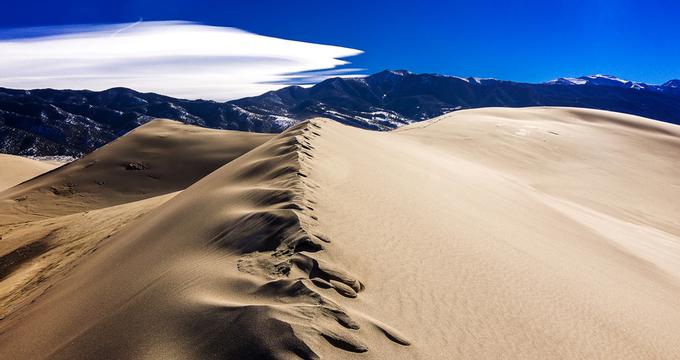Nestled against the rugged Sangre de Cristo Mountains in southern Colorado, the Great Sand Dunes National Park and Preserve is home to the tallest sand dunes in North America—some rising over 750 feet high. This surreal, otherworldly landscape blends wind-sculpted dunes, alpine peaks, wetlands, and grasslands in a setting that feels both ancient and awe-inspiring. It’s a place where geology, stargazing, and outdoor adventure meet in one unforgettable experience.
Recommended For
This unique national park is perfect for:
- Outdoor adventurers—interested in sandboarding, hiking, and backcountry camping
- Families and explorers—who want to sled down dunes or play in Medano Creek
- Stargazers and photographers—thanks to the park’s Dark Sky designation
- Nature and geology buffs—curious about ancient landscapes and shifting ecosystems
Park History & Geology
- Human history in the area dates back over 11,000 years
- Indigenous names included “Sand that Moves” and “Sandy Place Lake”
- Formed by ancient lakes, wind patterns, and shifting tectonic plates
- Sangre de Cristo Mountains show marine fossils—evidence they were once underwater
- San Juan Mountains formed from volcanic activity
- The San Luis Valley created a vast basin where sand accumulated and evolved into dunes
- Designated a national monument in 1932 to protect the fragile landscape
Featured Attractions
- Main Dune Field—towering dunes perfect for sand sledding and photography
- Medano Creek—a seasonal stream ideal for splashing and relaxing
- Star Dune—the tallest dune in North America
- High Dune on First Ridge—popular for panoramic sunrise views
Top Experiences
- Sand sledding and boarding—no experience needed, but proper equipment is essential
- Nighttime visits—perfect for stargazing in a quiet, pollution-free sky
- Backpacking and camping—primitive sites available within the preserve
- Nature watching—listen for owls, watch for wildlife, and respect their space
Visitor Tips
- Bring or rent real sand sleds or boards—avoid snow sleds or cardboard
- Red flashlights help protect nocturnal animals and improve night vision
- Watch for hot sand and shifting winds—go early in the day to avoid extreme heat
- Always check the weather forecast—lightning and strong winds are common
- Be cautious at night when driving—wildlife like moose may be on the road
Camping & Accessibility
- Pinyon Flats Campground and other primitive sites available in warmer months
- Winter camping not recommended from November through March
- High-clearance 4WD vehicles are needed for some remote areas
- Nearby towns offer lodges and rentals if camping isn’t your thing
Photography & Stargazing
- The park is an International Dark Sky Park, offering some of the clearest views of the Milky Way
- Sand formations, mountain backdrops, and the interplay of light and shadow make it a photographer’s dream
Visitor Center & Safety
- The Great Sand Dunes Visitor Center provides maps, expert advice, water, books, and gear
- Entrance fees are modest and support conservation efforts
- Permits and fee waivers available for eligible groups
- Respect the desert—it’s harsh, stunning, and unlike anywhere else
Plan Your Visit
- Address: Great Sand Dunes National Park and Preserve, Mosca, CO 81146
- Phone: 719-378-6395
- Website: nps.gov/grsa
Plan Your Trip


